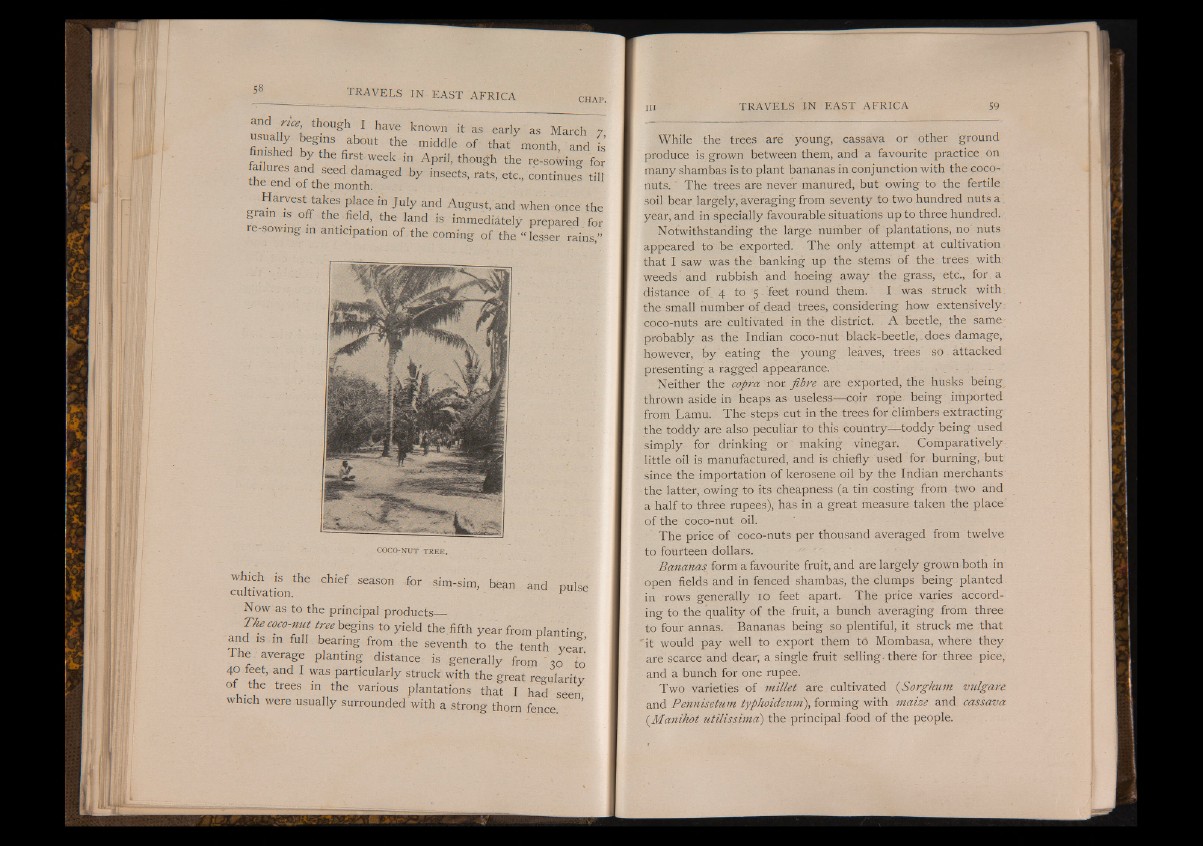
u ^ V hon8V *lave k now" 1 “ <*r'y 7.
finishid « 'he midd'e thaf raonth. a" d «
fail a st week ,n April, though the re-sowing for
the enH a f fFSe damaged by insects>tne end of the month. rats, etc., continues till
Harvest takes place in July and August, and when once the
grain is off the , field, the land is immediately prepared for
re-sowing m anticipation of the coming of the « lesser rains »
COCO-NUT TREE.
cultivation.'^6 ^ ^ ^ ^ ^ * *
Now as to the principal products_
The coco-nut tree begins to yield the.fifth year from planting
and is m full bearing from the seventh to the tenth year.
e . average planting distance is generally from 'ho to
40 feet, and I was particularly struck with the great regularity
f the trees in the various plantations that I had seen
which were usually surrounded with a strong thorn fence.
hi TRAVELS IN E AST AFRICA 59
While the trees are young, cassava or other ground
produce is grown between them, and a favourite practice on
many shambas is to plant bananas in conjunction with the coconuts.
' The trees are never manured, but owing to the fertile
soil bear largely, averaging from seventy to two hundred nuts a
year, and in specially favourable situations up to three hundred.
Notwithstanding the large number of plantations, no'nuts
appeared to be exported. The only attempt at cultivation
that I saw was the banking up the stems of the. trees with
weeds and rubbish, and hoeing away the grass, etc., for a
distance of 4 to 5 feet round them. I was struck with
the small number of dead trees, considering how extensively-
coco-nuts are cultivated in the district. A beetle, the same
probably as: the Indian coco-nut black-beetle,. does damage,
however, by'eating the young leaves, trees' so attacked
presenting a ragged appearance.
Neither the copra nor fibre are exported, the husks beings
thrown aside in heaps as useless— coir rope being imported
from Lamu. The steps cut in the trees for climbers extracting
the toddy are also peculiar to this country— toddy being used
simply for drinking or making vinegar. Comparatively
little oil is manufactured, and is chiefly used for. burning, but
since the importation of kerosene oil by the Indian merchants
the latter, owing to its cheapness (a tin costing from two and
a half to three rupees), has in a great measure taken the place'
of the coco-nut oil.
The price of coco-nuts per thousand averaged from twelve
to fourteen dollars.
Bananas form a favourite fruit, and are largely grown both in
open fields and in fenced shambas, the clumps being planted
in rows generally 10 feet apart. The price varies- according
to the quality of the fruit, a bunch averaging from three
to four annas. Bananas being so plentiful, it struck me that
"it would pay well to export them to Mombasa, where they
are scarce and dear, a single fruit selling, there for three pice,
and a bunch for one rupee.
Two varieties of millet are cultivated (Sorghum vulgare
and Pennisetum typhoideiun), forming with maize and cassava
(.Manihot utilissima) the principal food of the people.